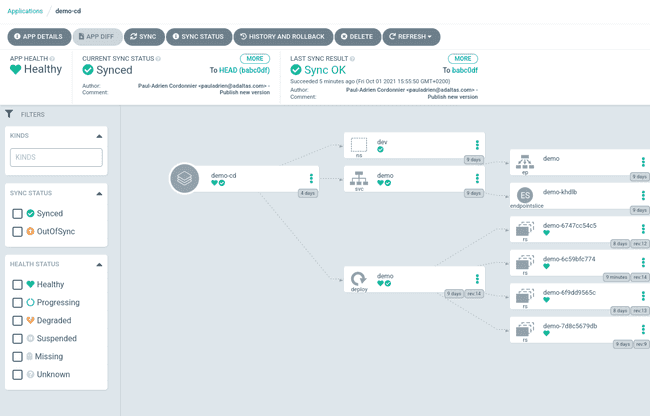GitOps is a set of practices to deploy purposes utilizing Git. Software definitions, configurations, and connectivity are to be saved in a model management software program resembling Git. Git then serves as the one supply of fact for the declarative infrastructure and its hosted purposes.
Utilizing GitOps implies that any change to the deployment have to be addressed in a git commit. A steady supply operator then diffs the commit and synchronizes the state between the repository and the focused atmosphere.
The primary benefit of GitOps is how each change is versioned and verifiable. Versionning makes it straightforward to roll again to a earlier state in case of errors. Catastrophe restoration can be simplified. The supply of fact stays unchanged and also you solely want to change the focused atmosphere.
The article current how we use ArgoCD to synchronize the state of our Kubernetes clusters. It covers its set up and usages utilizing a easy instance software hosted on GitHub.
Since Kubernetes manifests are declarative, it matches completely the CI/CD pattern and most GitOps instruments deal with Kubernetes.
In observe
It’s a good observe to isolate your software supply code out of your deployment state definitions between 2 distinct Git repositories. YAML recordsdata are used to explain the Kubernetes cluster, together with Deployments, ConfigMap, Secrets and techniques, …
The deployment state repository is organized with the structure:
./myapp-ops
├── base
│ ├── deployment.yaml
│ ├── kustomization.yaml
│ └── service.yaml
├── dev
│ ├── deployment-patch.yaml
│ └── kustomization.yaml
└── prod
├── deployment-patch.yaml
└── kustomization.yamlRight here we’re utilizing kustomize for our declarative configuration customization. dev and prod listing defines the state of our software and shares a typical base. Dev and Prod may be deployed in the identical or completely different Kubernetes clusters based on our wants.
The everyday workflow for a brand new characteristic in an software utilizing GitOPs is as comply with:
- The code is pushed to the code repository.
- The code is constructed and examined within the CI platform.
- The code is shipped: a docker picture is constructed and pushed to a registry.
- The CI pipeline commits and pushes a brand new model into to the deployment repository.
- This push triggers a synchronization: the brand new code is robotically deployed to the goal infrastructure.
Customers are free to decide to the deployment repository by themselves, for instance they’ll set the variety of ReplicaSet of a deployment.
ArgoCD
ArgoCD is a GitOps operator that synchronizes the state described in a Git repository with a deployment in a single or a number of Kubernetes clusters.
ArgoCD helps a number of format for the declarative definitions (Kustomize, Helm, Ksonnet or plain-YAML).
It’s implementend as a Kubernetes controller that displays the Git repository and the reside deployment. If for some motive the reside standing deviates from the goal (ready for person enter, deployment failed, handbook rollback…), the appliance is taken into account OutOfSync.
ArgoCD Set up
A easy ArgoCD set up is easy:
kubectl create namespace argocd
kubectl apply -n argocd -f https://uncooked.githubusercontent.com/argoproj/argo-cd/secure/manifests/set up.yaml
kubectl -n argocd get secret argocd-initial-admin-secret -o jsonpath="{.knowledge.password}" | base64 -d && echo
kubectl patch svc argocd-server -n argocd -p '{"spec": {"sort": "LoadBalancer"}}'
kubectl port-forward svc/argocd-server -n argocd 8080:443
The subsequent step is to put in the argocd-cli command following the official ArgoCD CLI installation.
Extra documentation on the set up (Person Administration, Excessive Availability, Observability …) can be found here.
ArgoCD Utilization
Now let’s create an ArgoCD app utilizing the CLI. It may be finished simply by way of the Net UI.
argocd login $myargocd:8443
argocd app create demo-app-dev --repo https://github.com/PACordonnier/demo-cicd-ops.git --path dev --dest-server https://kubernetes.default.svc --dest-namespace dev
argocd app get demo-app-dev
Title: demo-app-dev
Venture: default
Server: https://kubernetes.default.svc
Namespace: dev
URL: https://192.168.39.5/purposes/demo-app-dev
Repo: https://github.com/PACordonnier/demo-cicd-ops.git
Goal:
Path: dev
SyncWindow: Sync Allowed
Sync Coverage: Automated
Sync Standing: Synced to (babc0df)
Well being Standing: Wholesome
$ argocd app set demo-app --sync-policy auto
Navigating the Net UI, we are able to see all of the objects managed by ArgoCD in addition to their present state:
Conclusion
If you’re utilizing Kubernetes to your deployment and battle to concentrate on what’s deployed in your environments, GitOps is for you. Implementing it’s no rocket science and may solely profit your DevOps compliance.
ArgoCD is a good product. It solves an actual downside whereas being handy and straightforward to make use of.









